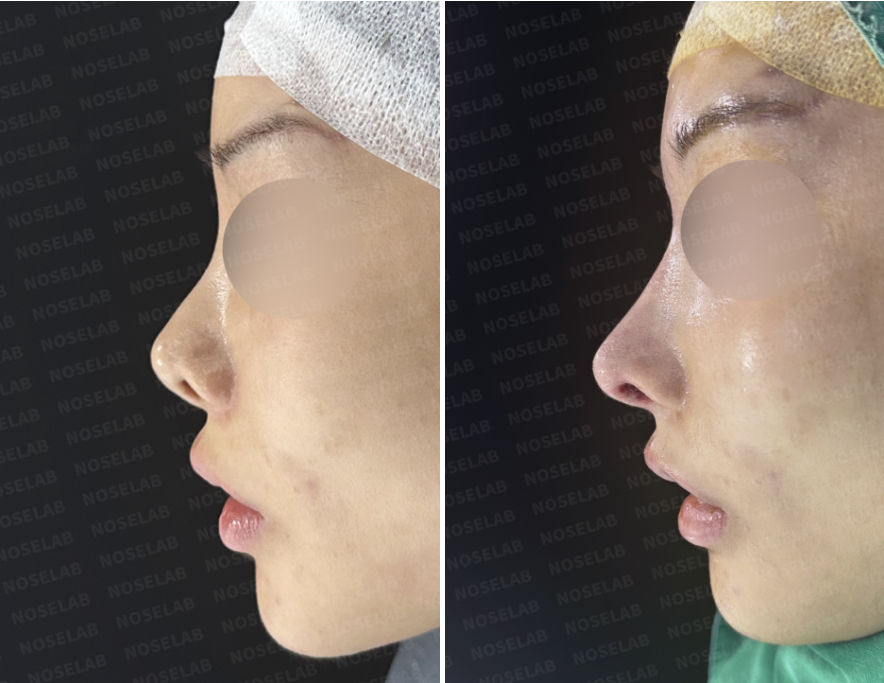Reconstructive Rhinoplasty for Contracted Nose and Nostril Asymmetry
- noselab
- 2024년 11월 8일
- 2분 분량
최종 수정일: 9월 26일
Hello, this is Dr. Cha-Young Kang, Director of Nose Lab Clinic.
Today, I’m sharing a case involving a 22-year-old male patient who experienced contracted nose and nostril asymmetry after multiple rhinoplasty procedures. This case highlights the risks of repeated nasal surgeries and the importance of safe, reconstructive rhinoplasty for contracted nose in achieving stable and natural results.

1. Patient’s Surgical History and Requirements
Surgical History:
2022: Cheekbone and jaw reduction surgery
2023: Septal and ear cartilage grafting with implant-free nostril reduction
2023: Revision surgery using autologous rib cartilage
2024: Nasal cartilage graft and implant-free surgery, followed by inflammation one week later requiring medication
Patient Goals:
Correct nostril asymmetry
Improve nasal structure and contour
2. Pre-Surgical Assessment for Reconstructive Rhinoplasty for Contracted Nose

Front View:
Visible nostril asymmetry
Noticeable deviation
Side View:
Low nasal bridge
Short, upturned tip
Nostril View:
Columella tilted to the left with nostril asymmetry
Due to inflammation from previous surgeries, stem cell therapy was first recommended. Definitive reconstructive rhinoplasty for contracted nose was scheduled three months later for optimal recovery.
3. Surgical Plan in Reconstructive Rhinoplasty for Contracted Nose
Lateral Osteotomy: Correcting the deviated bridge
Autologous Rib Cartilage Reconstruction: Rebuilding the nasal bridge and tip without implants for durability
Septal Reconstruction: Repairing septal damage from prior surgeries
Nasolabial Angle Correction: Improving facial harmony
4. Post-Surgical Results

Side View:
Smooth, natural profile after correcting uneven, low bridge
Improved nasolabial angle

Oblique View:
Refined bulbous tip for better definition
Proportionally elevated bridge

Front View:
Clear improvement in alignment and symmetry
Reduced nostril asymmetry

Nostril View:
Corrected columella tilt
Balanced nostril shape
5. Understanding Implant-Free Rhinoplasty in Reconstructive Rhinoplasty for Contracted Nose
Implant-free rhinoplasty, especially in reconstructive rhinoplasty for contracted nose, uses natural tissues such as cartilage or dermis instead of synthetic implants.
Pros:
Lower infection risk
More natural look and feel
Cons:
Less predictable contouring
Limited shaping compared to implants
In this case, autologous rib cartilage provided stable support and minimized risks.
Final Thoughts
Patients with contracture and asymmetry require cautious planning. Reconstructive rhinoplasty for contracted nose should only be performed after full recovery and with safe materials.
At Nose Lab Clinic, we are committed to safe, effective, implant-free rhinoplasty tailored to each patient.
Thank you,
Dr. Cha-Young Kang, Director of Nose Lab Clinic
👉 At Nose Lab, all surgeries are performed using a closed (endonasal) approach.

Messenger(WhatsApp) : +82 1057360302
Home page : www.noselab.co.kr
Instagram : noselab_global
YouTube : Noselab
Email : noselab@naver.com



댓글